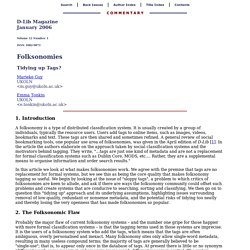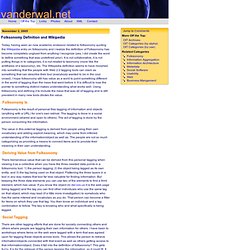

The Hive Mind: Folksonomies and User-Based Tagging. By Ellyssa Kroski There is a revolution happening on the Internet that is alive and building momentum with each passing tag. With the advent of social software and Web 2.0, we usher in a new era of Internet order. One in which the user has the power to effect their own online experience, and contribute to others’. Today, users are adding metadata and using tags to organize their own digital collections, categorize the content of others and build bottom-up classification systems. The wisdom of crowds, the hive mind, and the collective intelligence are doing what heretofore only expert catalogers, information architects and website authors have done.
User-Based Tagging and Folksonomies Unlike social-networking sites such as LinkedIn and Friendster, which concentrate on developing relationships, social sites such as del.icio.us, 43Things and Flickr focus their attention on organizing data. Del.icio.us is a social bookmarking site. 43Things is like a giant, global to-do list. Delicious MK II - looks great and ready to go - Richard Filing. Folksonomies: Tidying up Tags? 1.

Introduction A folksonomy is a type of distributed classification system. It is usually created by a group of individuals, typically the resource users. Users add tags to online items, such as images, videos, bookmarks and text. These tags are then shared and sometimes refined. In this article we look at what makes folksonomies work. 2. Probably the major flaw of current folksonomy systems – and the number one gripe for those happier with more formal classification systems – is that the tagging terms used in those systems are imprecise.
Some users do not consider this a problem; they may argue that tags are there primarily to help the particular end-user who is submitting them. 3. So what exactly are tags? Two well-known examples of folksonomy systems, to which we will refer extensively in this article, are del.icio.us™ [3] and flickr™ [4], both services owned by Yahoo. Power laws and tag distribution Tag popularity Figure 1: Popularity of randomly sampled flickr tags 4. Educating users. Folksonomy Definition and Wikipedia vanderwal.net. Today, having seen an new academic endeavor related to folksonomy quoting the Wikipedia entry on folksonomy and I realize the definition of Folksonomy has become completely unglued from anything I recognize (yes, I did create the word to define something that was undefined prior).

It is not collaborative, it is not putting things in to categories, it is not related to taxonomy (more like the antithesis of a taxonomy), etc. The Wikipedia definition seems to have morphed into something that the people with Web 2.0 tagging tools can claim as something that can describe their tool (everybody wanted to be in the cool crowd). I hope folksonomy still has value as a word to point something different in the world of tagging than the mess that went before it.